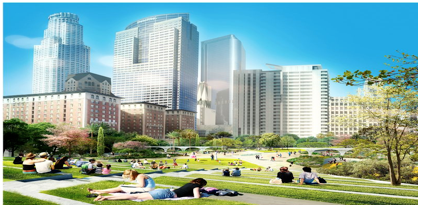DEEGAN ON LA-The aspiring streetwear-star with a bankroll meets the hard-bitten political operative. The result? Instead of working with each other’s vibe to make one and one equal two (a big win for the community,) we have zero. What they planned -- a basketball court in Runyon Canyon Park -- has unraveled, becoming a seriously controversial issue. This could not have been the intention when what many emphatically call a “secret, back-room deal” was put together. Yet we see what can happen when not enough daylight is cast on the process. Things get overlooked in those deep dark recesses. Instead of “what can we get?” it ends up being “what can we get away with?”
Hubris and reckless behavior lead to missed opportunities to serve the community. Just consider the mocking statements that were recently published online. This includes, “Ryu’s in our pocket. That’s why this (Runyon Canyon basketball court) went that far. LOL. Just a matter of time till we throw that basketball court in there. They just waiting for the right time playas”, and “Com’n man we run Runyon Canyon playaz! We do music videos up here. Smoke sessions up heya!” And, “Out with the Old and in with the New. Can’t stop it, Won’t stop it!” These public boasts were made by Mike Sabando, obviously a supporter of FORC’s (Friends of Runyon Canyon) plan to install a corporate-branded commercial basketball court in Runyon Canyon Park, but otherwise a random social media unknown. This is indicative of the chatter that’s been characterizing this star-crossed project.
That Councilmember David Ryu (CD4) would be in Sabando’s pocket is hilarious, but the rhetoric shows how this controversy, and the delusion, is metastasizing instead of settling down.
It’s been exactly four weeks since the lid blew off this situation when an unsuspecting public learned, what they say was for the first time, about development and commercialization plans in the park under the auspices of Friends of Runyon Canyon, a public benefit support group empowered by the LA Rec and Parks department to find “deals” to bring it revenue in exchange for “sponsorships.”
The Friends of Runyon Canyon (FORC) is a California 501-3 (c) corporation, whose status is granted by the Attorney General of California. It is considered a charity. Locally, they are supervised by the Department of Recreation and Parks. And the CD4 office has great sway over them, as well.
What they themselves need now are some friends. It could be time for a make-over in how the community they are supposed to be serving views them. Nineteen public comments were submitted about FORC at a hearing of the Board of Commissioners of Recreation and Parks on May 4. They all amounted to the same request to the board: “Immediately dissolve FORC.”
At this meeting, Catherine Landers, Ryu’s Hollywood deputy, confirmed that construction of the basketball court had stopped. This follows Ryu’s recent public announcement that, "Per my request, the Department of Recreation and Parks will halt construction of the proposed basketball court at Runyon Canyon Park, and the department also agreed with my recommendation to have the Board of Recreation and Parks commissioners reconsider its prior approval of the project."
FORC is likely come under more scrutiny because of its dual-status as a charity and city surrogate, due to the deal they made with the Department of Recreation and Parks (RAP) making them a proxy of RAP in stewarding Runyon Canyon Park. That adds a layer of expected public accountability, transparency and engagement, the same as if dealing with a city official.
FORC can no longer operate as a closed-door, candle-lit, membership-by-invitation organization with a $5,000 suggested donation -- a clubhouse for an elite few. Openness is their best offense as they struggle to get ahead of some very bad public relations. They granted branding rights in the park to a donor, but now their own brand is hurting.
Both RAP and CD4 are aware that this is serious. Being a public benefit charity, and a proxy for the city, it’s easy to understand why there have been calls for much more oversight and transparency than FORC has been receiving or providing. Change must come, willingly or mandated, beginning with a program of transparency.
Extra scrutiny is now being promised by grass roots activist groups like Runyon Canyon Defenders and others, that may have had investigators at the County Recorder, pulling plot maps and parcel information for an-about-to-be-announced acquisition of 2450 Solar Dr.
The land acquisition is great for the park and for the wildlife, and has been in the works for many years prior to FORC entering the picture.
Another player in this game, FORC’s streetwear partner in the park, is not regulated except by the economics of supply and demand. Their new product line, “Summer 2016 Dolphin Motorsports Legacy 1.1,” went on sale April 30. It cannot hurt their brand’s street marketing campaign to be in the midst of a controversy like the mess at Runyon Canyon Park when they are dropping their product into the marketplace. The four weeks leading up to that release has been a publicity bonanza for them. Their street cred may actually be increasing from being at the epicenter of this dispute. “There’s no such thing as bad publicity,” said P. T. Barnum, a 19th century American showman, prankster and circus owner.
Right now, it feels like the math adds up to plus one for the streetwear brand and minus one for FORC. But the sum is still zero, even though the streetwear partner, who is a FORC board member, gave FORC a quarter-million dollars to provide park improvements. There’s nothing wrong with that, except that, apparently, it was never revealed or stated publicly during negotiations with Recreation and Parks that the donor was an insider board member who would benefit by receiving a corporate designation in the park -- along with a huge tax-write off and other benefits.
“Neither staff nor I knew that the donor was a (FORC) board member during negotiations…” [that would receive value that] “would directly benefit his company,” states the RAP executive that conducted the negotiations.
When asked by CityWatch, a FORC spokesperson denied that the board seat appointment existed during negotiations, even when challenged by being shown a timestamped social media screenshot from the donor captioned, “With my fellow board members the other night at one of our fundraisers for Runyon Canyon Park. I’m super excited to part of this organization and can’t wait to see some of our initiatives come to life.” (Like his corporate-branded basketball court!)
This social media announcement was uncovered and verified by neighborhood activists, in classic political “truth squad” fashion, as being made at a FORC fundraiser held during the period that RAP was negotiating with the donor (a FORC board member.) who was then awarded valuable concessions by Recreation and Parks during the talks. It raises the question: was this self-serving insider dealing? Yes or no, it’s not the kind of shadow that people trying to brand themselves as philanthropists would want hanging over them. Google searches last forever.
When the timestamp was pointed out, the streetwear star responded by erasing the caption. This is how cover-ups start…one small erasure becomes a termite and, before you know it, the house collapses.
Councilmember David Ryu (CD4), a major player in this controversy that is in his district, has stepped in to lead the effort to clean up the mess. His goal is to refocus attention where it is needed -- on the future of Runyon Canyon Park, a regional park which must be readied over the next few years to welcome everybody, including millions of visitors and dogs. If Ryu plans to continue working with either of these players in determining the future of Runyon Canyon Park, he has his work cut out for him. He’ll need to help shift the debate from character assessment to park assessment.
Boss Tweed, the head of New York City’s infamous Tammany Hall political machine (circa 1800’s), was famous for this political advice: “Don’t write it, if you can say it. Don't say it, if you can wink or nod.” The political pro at the heart of FORC seems to be mimicking Tweed when he starts an initial conversation with CityWatch by saying, “can’t we just make this story go away?” When told no, he then asked that nothing be in writing, wanting to just meet for coffee and talk, saying, “I hate using email.”
So, are we in the shadows of disgraced politicos -- LBJ and his credibility gap, Nixon and his cover-ups, Boss Tweed’s manual of evasive tactics, and a twist of P.T. Barnum? Who and where are the political mentors to guide what started out as well-intentioned citizens, volunteers doing “the people’s business”?
The spotlight will shortly be on one player who is trying to stay below the radar as things get more complicated – the councilmember who is the chair of the City Council’s Arts, Parks, and River Committee. He is a colleague and campaign consultant client of the FORC board member taking the most heat. In Tweed-speak, he might be the “grease” for this deal…he may have a key to the clubhouse. His committee has an appeal on its docket filed by lawyers to challenge the November 4, 2015 determination by the Board of Recreation and Park Commissioners finding that construction of a basketball court at Runyon Canyon Park is exempt from CEQA pursuant to Article III, Section 1(y), Class 11, Categories 3 and 6 of the City's CEQA Guidelines.
Another mentor must now be David Ryu. This mess is in his district, and, while he is slowly taking steps to clear it up, time will tell if he’s able to pull the variety of disparate, discordant interests together to find a solution that makes sustainability of the park as the top priority. Populations and demographic shifts are variables that will continue to bring new voices into any civic conversation, but the raw earth and nature -- the park -- remains the constant. It must be protected and improved for everybody.
FORC has a chance to be a star, but must first become a transparent player; its website should include every minute of every meeting, a full financial disclosure report, the agreement with the streetwear donor and any other donors, and an accurate listing and biography of its directors and their terms of office. In addition to their fundraising, they must start “friend-raising” in the community that uses the park. As a quasi-public agency they must not discriminate about who can be a member and should open their doors to all.
David Ryu can seek full public disclosure by FORC today. He does not need anything but the inherent power of his office to demand that. The credibility of FORC, and their fiduciary role as a fundraiser for the city, is on the line. They are at a turning point, poised to do great things.
Waiting for a lawsuit to be filed in order to bring a motion to the City Council so it can act on the issue may be a purely technical response. The lawsuit, filed on April 27 and prepared by Citizens Preserving Runyon, is waiting in the wings, held off only by David Ryu’s request to RAP for a review of the situation. But the threat of looming litigation is not the only leverage Ryu has: he can use his bully pulpit.
With the appeal now pending in Committee, there will soon be a step forward in clarifying one key issue -- CEQUA compliance. CEQA, or the California Environmental Quality Act, is a statute that requires state and local agencies to identify the significant environmental impacts of their actions and to avoid or mitigate those impacts, if feasible.
It’s time to move out of damage control and into a proactive stance about how to make Runyon Canyon Park the best public resource it can be for all communities. It’s time to move the conversation from silly remarks on social media to serious talk among the professionals that are charged with protecting our parks. It’s time to open dialogue with all the communities that FORC, RAP and CD4 serves.
A lot has happened in 30 days. Much of it good.
Other articles in this series include: “Lessons Learned from the Runyon Canyon Dispute? Time will Tell!” and “LA Councilman Puts the Brakes on Runyon Canyon Basketball Court … as the Growing Pains Continue.”
(Tim Deegan is a long-time resident and community leader in the Miracle Mile, who has served as board chair at the Mid City West Community Council and on the board of the Miracle Mile Civic Coalition. Tim can be reached at [email protected].) Edited for CityWatch by Linda Abrams.


































